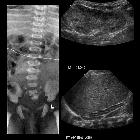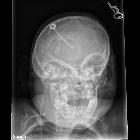renal agenesis




















Renal agenesis refers to a congenital absence of one or both kidneys. If bilateral (traditionally known as the classic Potter syndrome) the condition is fatal, whereas if unilateral, patients can have a normal life expectancy.
Epidemiology
Unilateral renal agenesis affects approximately 1 in 500 live births while bilateral agenesis is less common affecting approximately 1 in 4000 live births. There may be a slightly greater male predilection.
Clinical presentation
If renal agenesis is unilateral and isolated then patients are asymptomatic. Unless identified on antenatal screening, then it is found incidentally when the abdomen is imaged for other reasons. Occasionally patients with unilateral renal agenesis, develop secondary hypertension.
Those with bilateral renal agenesis often have additional birth defects, both associated with, and a result of the absence of kidneys. With no kidneys, the fetus is unable to produce urine, which is necessary to form amniotic fluid resulting in anhydramnios. As a result, severe oligemia is present with the main resultant abnormality being pulmonary hypoplasia.
Pathology
The etiology in many cases of renal agenesis is currently unknown but is thought to be multifactorial. An early vascular insult to the developing ureteric bud has been proposed .
Embryologically renal agenesis results from a failure of the proper development of the metanephros (the future definitive adult kidney) resulting in the complete absence of a renal structure. This is thought to occur at around early pregnancy (~6-7 weeks). Abnormalities in the mesonephros may result not only in renal agenesis (due to the absence of induction of the metanephros by the ureteral bud) but also internal genital malformations (due to the failure of the Wolffian and Mullerian duct to develop or to involute).
Associations
Renal agenesis can be associated with a number of chromosomal abnormalities including:
- trisomy 21
- other fetal trisomies
- trisomy 22
- trisomy 7
- trisomy 10
- 45X mosaicism
- Turner syndrome
- 22q11 microdeletion
Unilateral renal agenesis may have other associated birth defects (most commonly, involving the genitourinary system). Such include:
- Mullerian duct anomalies/MURCS association
- congenital heart disease
- skeletal abnormalities: e.g. clubfeet
- branchio-oto-renal dysplasia (BOR) syndrome
- Potter syndrome/sequence
- VACTERL association
- seminal vesicle cysts (males)
- seminal vesicle agenesis
- Gartner duct cysts (females)
- adrenal agenesis
- sirenomelia
- Diamond-Blackfan anemia
Other associations with unilateral renal agenesis include:
Radiographic features
Antenatal ultrasound
With the widespread use of antenatal ultrasound, renal agenesis can be identified in utero, although the presence of normal amounts of amniotic fluid and urine in the bladder results in the diagnosis being frequently missed, unless specifically and routinely looked for. Features include :
- absent kidney
- absent ipsilateral renal artery
- compensatory hypertrophy of the contralateral (opposite) kidney
- the term lying down adrenal sign as been ascribed to the elongated appearance of the adrenal not normally molded by the adjacent kidney
- care must be taken not to mistake the low lying adrenal gland (large in fetuses) for a kidney
- careful examination of the rest of the abdomen should be carried out to ensure that an ectopic kidney is not present (more common than renal agenesis) as well as of the 'single' kidney to ensure it does not represent crossed fused renal ectopia.
- color Doppler interrogation may aid in showing absence of renal arteries
If renal agenesis is bilateral then features are much more dramatic:
- oligohydramnios or anhydramnios (after 17 weeks)
- non visualization of the bladder
Postnatal ultrasound, CT and MRI
All imaging modalities will demonstrate the absence of a kidney, with the associated hypertrophy of the single kidney. Again, care must be taken not to misinterpret crossed fused renal ectopia for renal agenesis.
Treatment and prognosis
Most individuals with unilateral renal agenesis lead normal lives although there is an increased risk of renal infections, nephrolithiasis, hypertension and/or renal failure. No specific treatment is necessary.
Bilateral agenesis is lethal with pulmonary hypoplasia being the most common cause of death. Bilateral renal agenesis is said to carry a recurrence risk of 3% for sporadic cases.
Differential diagnosis
It is important to differentiate between renal agenesis and a small atrophic kidney, and, of course, to ensure that the kidney is actually missing (i.e. check for a pelvic ectopic kidney or crossed fused renal ectopia).
Provided the remaining kidney is normal, and the other kidney is truly absent, then the only real differential is that of a previous nephrectomy.
Siehe auch:
- VACTERL-Assoziation
- angeborene renale Anomalien
- Poland-Syndrom
- Turner-Syndrom
- Rubinstein-Taybi-Syndrom
- Akrorenales Syndrom
- Mikrodeletionsyndrom 22q11
- gekreuzte Nierendystopie mit Verschmelzung
- Smith-Lemli-Opitz-Syndrom
- Kallmann-Syndrom
- CHILD-Syndrom
- Fraser-Syndrom
- MURCS association
- Wolf-Hirschhorn-Syndrom
- Williams-Beuren-Syndrom
- Zinner-Syndrom
- Renale Adysplasie
- Agenesie von Niere und Samenblase auf der gleichen Seite
- Branchio-oto-renales Syndrom
- sirenomelia
- Holzgreve-Wagner-Rehder-Syndrom
- XYY-Syndrom
- Katzenschrei-Syndrom
- Diabetische Embryopathie
- Sommer-Rathbun-Battles-Syndrom
- Uterus didelphys mit obstruierter Hemivagina und ipsilateraler Nierenagenesie
und weiter:
- genitourinary curriculum
- obstetric curriculum
- Uterus didelphys
- kongenitale pulmonale Atemwegsmalformation (CPAM)
- multizystische Nierendysplasie
- Oligohydramnion
- Klumpfuß
- fetal conditions associated with maternal diabetes
- Trisomie 22
- gartner duct cyst
- VATER
- microtia
- singuläre Nabelschnurarterie (sNSA)
- Potter-Sequenz
- Nierenhypoplasie
- Anhydramnion
- Uterus unicornis
- MRKHS
- amniotic fluid discordance
- VATER anomaly
- Polysplenie-Syndrom
- two vessel cord
- obstruierte Hemivagina und ipsilaterale renale Anomalie (OHVIRA) Syndrom
- dilatierte Samenbläschen mit multiplen Zysten
- MRKH
- branchio-oto-renal dysplasia
- Nierendysgenesie
- Uterusagenesie
- Nephromegalie
- Entwicklungsanomalien der Niere

 Assoziationen und Differentialdiagnosen zu einseitige Nierenagenesie:
Assoziationen und Differentialdiagnosen zu einseitige Nierenagenesie:








